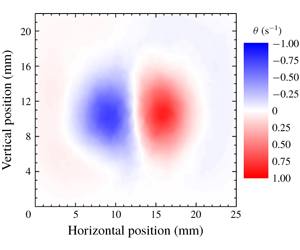Article contents
An experimental study of turbulent vortex rings in superfluid 4He
Published online by Cambridge University Press: 24 February 2020
Abstract

Macroscopic vortex rings are generated thermally in superfluid4He, between 1.28 and 1.95 K, by applying a brief voltage pulse to a resistive heater located below a circular vertical tube 5 mm in diameter and 20 mm high. The rings form above the tube and propagate upward with velocities of the order of  $10~\text{mm}~\text{s}^{-1}$, resulting in Reynolds numbers up to
$10~\text{mm}~\text{s}^{-1}$, resulting in Reynolds numbers up to  $10^{5}$. We visualize their cross-section, of size comparable with the tube diameter, by capturing the motions of relatively small solid deuterium particles, previously dispersed in the quiescent bath of superfluid 4He. We employ particle positions and velocities to compute the Lagrangian pseudovorticity, which can be seen as a measure of the ring strength and which allows us to identify and track these objects. We thus obtain time-dependent sizes, positions and velocities of the vortex rings. We show that, in the range of investigated parameters, these rings behave as if they were turbulent vortex rings moving in classical viscous fluids, at least in the direction of ring propagation. The outcome reinforces the view that the study of turbulent flows of superfluid 4He is not only interesting in its own right, but that it can also contribute to our current understanding of fluid turbulence in general.
$10^{5}$. We visualize their cross-section, of size comparable with the tube diameter, by capturing the motions of relatively small solid deuterium particles, previously dispersed in the quiescent bath of superfluid 4He. We employ particle positions and velocities to compute the Lagrangian pseudovorticity, which can be seen as a measure of the ring strength and which allows us to identify and track these objects. We thus obtain time-dependent sizes, positions and velocities of the vortex rings. We show that, in the range of investigated parameters, these rings behave as if they were turbulent vortex rings moving in classical viscous fluids, at least in the direction of ring propagation. The outcome reinforces the view that the study of turbulent flows of superfluid 4He is not only interesting in its own right, but that it can also contribute to our current understanding of fluid turbulence in general.
Information
- Type
- JFM Papers
- Information
- Copyright
- © The Author(s), 2020. Published by Cambridge University Press
References
- 6
- Cited by

